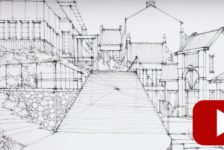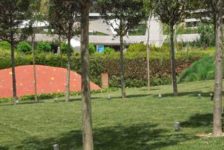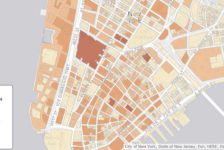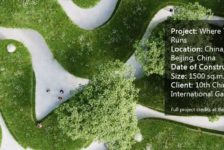Long before Los Angeles was stereotyped as a place that didn’t respect age or heritage, its terrain had been transformed from hillside native chaparral, oak woodlands, and riparian meadows to a regularized landscape of exotic evergreen trees, tropical palms, and green lawns. This botanical metamorphosis was spurred by Southern California’s unusual ability to grow the vast majority of the world’s plant species—given enough imported water.
By the 1950s, Los Angeles had found its own special place in garden history for having the finest, most pristine specimens of the flat, sterile, suburban yards that defined the era.
There has never been much historic consideration for the region’s subtle seasonal changes, and there have been shamefully few examples of landscape design even attempting to harness the spectacle of California’s vast poppy fields or the sculptural, shaded cathedrals found beneath our majestic native oaks. But now, four years of drought are finally forcing us to confront the limitations of these revisionist landscapes.
The Obsolescence of Canned Green Beans
Although Americans have moved on from many other midcentury values, Angelenos’ landscapes still reflect the way people wanted to live 75 years ago. How then can we update our values? The Slow Food Movement, begun in 1986 by Carlo Petrini to protest the opening of a McDonald’s near the Spanish Steps in Rome, provides a positive and applicable analogue to L.A.’s future landscape.
In recent years, more diverse demographics and lifestyles have combined with a better scientific understanding of diet and health to create a new normal in dining and an interest in rediscovering slow, local, and heirloom foods. Chefs around the world are now driven by the desire and attempt to keep local color, freshness, and authenticity in our cities. Vibrant, experimental restaurants serving regional and site-specific, farm-to-table/dock-to-dish cuisine have popped up across the nation. This way of thinking about food has crossed over to home cooking as well, with the proliferation of neighborhood farmers’ markets and the display of heirloom, organic produce and grass-fed beef as standard fare at many local supermarkets.
This groundbreaking and relatively rapid shift in the way Americans eat may very well parallel an imminent sea change in the way we consider and develop our landscapes. If canned green beans are no longer our go-to vegetable, why should exotic lawn grass continue to be our go-to landscape? Californians were among the first to embrace the Slow Food Movement; the current drought’s water restrictions are impetus for us to recognize and support a Slow Landscape Movement.
A Slow Landscape Movement would create the framework for designing regional American landscapes that are more appropriate for our times. By designing landscapes that combine performative infrastructural technology with deep understanding of regional flora, fauna, and ecosystem function—and adding a large and crucial helping of creative artistry—we can make places that not only become more authentically rooted in Los Angeles, but can help lead the way for other U.S. cities to do the same. In fact, since Hollywood will most likely export images of our most successful and beautiful “Slow Landscapes,” interest in which specific landscape “ingredients” define a region’s own characteristics would grow.
Moving away from the monotonous overuse of passé and thirsty lawn grass is a great first step. In our front yards, sidewalk parkways, and street medians, grass is little more than a maintenance headache. What if we reconceived and replanted those areas with plants more suited to our climate and resources? In addition to using less water than grass, native, drought-tolerant plants require very little maintenance. They typically need supplemental water for just one or two years until establishment, and they rarely require the excessive use of petrochemical fertilizers or pesticides. Our neighborhoods in aggregate would utilize fewer resources and provide a healthier habitat for birds and beneficial insects.
Just as important for designers, our residential streets would have more identifying character. Many of Los Angeles’s most distinctive streetscapes derive their historic identity from the use of a single street-tree species, such as the towering Washingtonia palm. If the ground cover plantings under these established trees were indigenous, the many possible combinations within the street-tree system would increase neighborhood and street-to-street differentiation. Simply removing the pervasive lawn and replacing it with better-suited understory plants would have an impact at the urban scale. The floral diversity under the trees would make it easier to understand where in the world you are at a glance, telling a more authentic and healthy story of a place.
Embracing Slow Landscapes
It is inherently false that El Niño would render such drought-tolerant Slow Landscapes obsolete. Episodic El Niño winters are as much an integral part of the California climate as sporadic drought is. These extreme climatic cycles are not an aberration requiring a dramatic but temporary solution; our landscapes are neither instant nor static, but instead ebb and flow with the amount of rainfall. Acceptance of this variability is the essence of a movement toward Slow Landscapes. We will need to reexamine our landscape values and discover together what it means to live in Los Angeles.
Temperatures are increasing, and as soil moisture and water bodies evaporate rapidly under the one-two punch of extended drought and the advance of global climate change, it will be ever more crucial for Slow Landscapes to build in resilience and acceptance of seasonal and multiyear extreme weather fluctuations.
For the Los Angeles context, Slow Landscapes will mean, in part, bringing seasonality to our gardens and stressing acceptance of the “California Gold” of summer, along with the verdant green of winter. The great landscape gardens of the world rely on the “good bones” of a strong winter garden framework to define the ephemeral beauty of plantings. In other cultures, trees and plants that change color, lose their leaves, provide fleeting flowers, or patterned winter bark are revered for the reference they provide to the life cycle.
The “bones” of our Los Angeles gardens don’t necessarily have to be organic. Our city’s staggering aesthetic richness provides abundant opportunity for designers to merge novel, locally inspired forms and motifs with the dynamic living element of our indigenous flora. Imagine sprays of Rosa californica, the delicate pink native rose, draped upon trellises influenced in form by the sinewy infrastructural exoskeleton of the concrete freeways and waterways. Or sultry bright sages, evoking the dream of the Old West, laid out in parterre geometry derived from cultural icons, such as street art, graffiti, or commercial signs and marquees.
If the drought has a silver lining, it may be that more slow and thoughtful technology and capital are being focused on urban-scale infrastructural improvements that finally hybridize ecological and cultural needs. The reality is that Los Angeles’s landscape has become an engineered environmental system that now needs to be reckoned with. Ecological issues, including soil health, heat-island effect, appropriate vegetation, habitat, and water use, collection, and recharge, all need to be weighed when considering our landscapes. True performance-based landscapes are still the minority of design projects, but this is changing rapidly. In addition, awareness of how cultural influences can and should affect our landscapes is growing.
The time is right to slow down and be ever more thoughtful in how we design and engineer our landscapes to create richer, more interesting, and more resilient spaces that are genuine and redolent of the best of an area’s native environs. Samantha Harris is a landscape architect and artist. A principal at Rios Clementi Hale Studios, she is a founding member of the studio’s Slow Landscape Initiative.
Taking cues from the Slow Food Movement, the future of landscape in the West is local and resilient, with or without a drought.
This article was originally published the February 24, 2016 print edition of The Architect’s Newspaper West, and is online here.
Published in Blog








